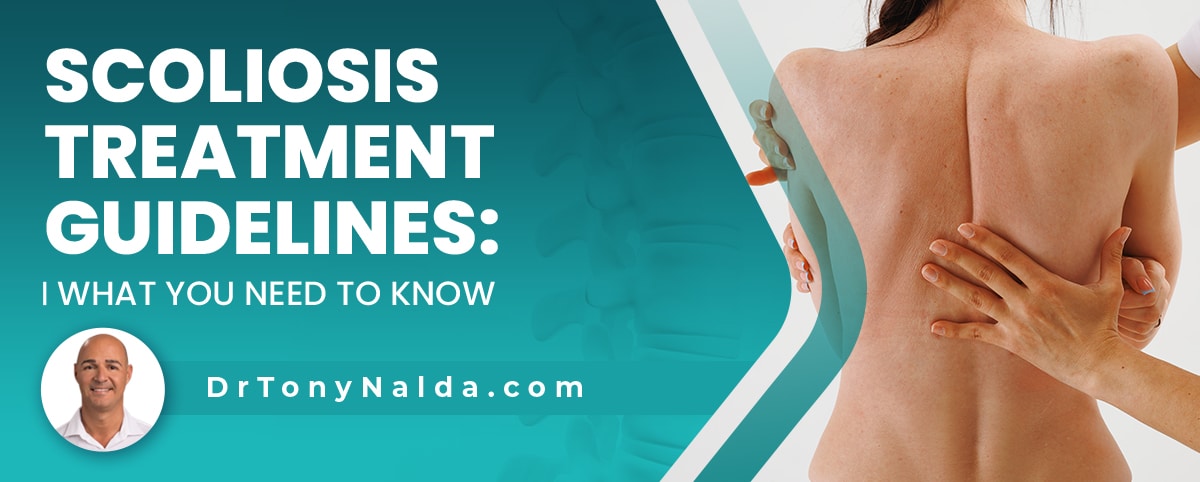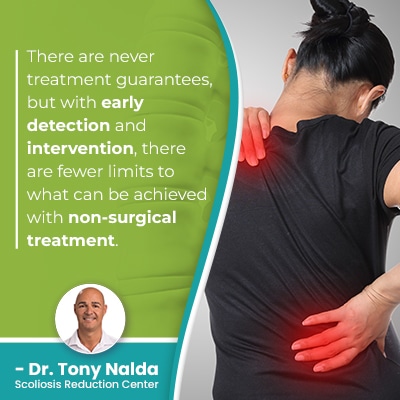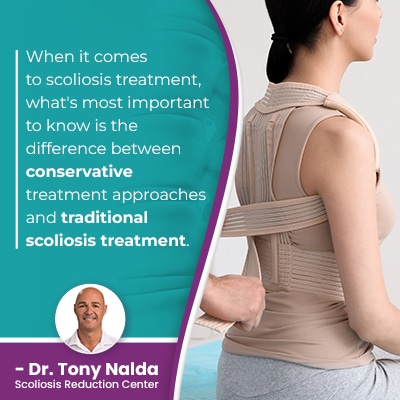Scoliosis Treatment Guidelines: What You Need to Know

Following a diagnosis of scoliosis, the most important decision to be made is how to treat it moving forward, and this is because when treatment is started, and the type of treatment started, can have far-reaching effects. While there are no treatment guarantees, although scoliosis is progressive, it can be highly treatable.
What you need to know about scoliosis treatment is that different types shape spinal health differently; early detection and intervention are key. Scoliosis can be addressed with or without surgery, and nonsurgical therapy is proactive and healthier for the spine.
As scoliosis treatment starts with a diagnosis, let's explore how a diagnosis is reached.
Table of Contents
Diagnosing Scoliosis
Scoliosis isn't the only spinal condition that causes a loss of the spine's healthy curves, but as the leading spinal deformity among school aged children, it should always be taken seriously.
Scoliosis causes the spine to bend unnaturally to the side and twist, making it a 3-dimensional condition, and being diagnosed with scoliosis also means being diagnosed with a progressive condition whose nature is to get worse over time.
Scoliosis is diagnosed through a physical examination that often includes an Adam forward bend test and X-ray results.
An X-ray is needed to officially diagnose scoliosis as the spine's rotational component needs to be confirmed, along with a patient's Cobb angle measurement.
Scoliosis progression is a key condition characteristic that treatment plans are shaped around, and there are two main scoliosis treatment approaches for patients to choose between, and I want to make sure that the differences between the two are fully understood so informed choices can be made.
So the first thing you need to know about scoliosis is that as a progressive condition, the timing of treatment is important, and this means understanding the benefits of early detection and intervention.
Early Detection and Intervention
 There are never treatment guarantees, but with early detection and intervention, there are fewer limits to what can be achieved with non-surgical treatment.
There are never treatment guarantees, but with early detection and intervention, there are fewer limits to what can be achieved with non-surgical treatment.
What everyone needs to know about scoliosis is that as a progressive condition, the milder it is when diagnosed and the sooner treatment is started, the more responsive the spine is likely to be.
As progression occurs, the size of the unnatural spinal curve is increasing in size, and this makes the spine more rigid, less responsive, and difficult for some patients to perform key therapeutic exercises.
So the sooner treatment is started, the more flexible the spine is, the milder the condition is, and with early detection and a proactive treatment approach, that can mean starting treatment when conditions are the simplest to treat.
As the effects of scoliosis become more overt with progression, another benefit of early detection and intervention is working towards preventing progression also means preventing the effects of progression, like increasing postural changes.
Growth and Progressive Idiopathic Scoliosis
What's important to understand about the progressive nature of scoliosis is that progression is triggered by growth spurts, which is why childhood scoliosis can progress so quickly.
In children, the main symptoms of scoliosis involve postural changes caused by the condition's uneven forces disrupting the body's overall symmetry:
- Head appearing uncentered over the torso
- An uneven eye line
- Uneven shoulders
- Uneven shoulder blade
- Uneven hips
- The development of a rib hump
- Arms and legs that appear to be different lengths
These types of changes are going to become more noticeable with progression, and in most cases, it's more effective to proactively work towards preventing their development than it is to attempt to reverse once they're established.
The longer scoliosis curves are left untreated, the more established the effects become, and over time, risk of curve progression increases as spinal degeneration becomes a factor in adult scoliosis.
So early detection and intervention are beneficial because they can mean starting treatment of idiopathic scoliosis when a scoliosis curve is at its mildest and most likely to respond well.
What you also need to know is that there are multiple types of scoliosis, with their own unique characteristics and treatment needs.
The Four Main Types of Scoliosis
The main type of scoliosis to affect all ages is idiopathic scoliosis, meaning no single-known cause; instead, idiopathic scoliosis is thought to be multifactorial: caused by multiple variables, or a combination of factors, that can vary from person to person.
The most prevalent type of scoliosis overall is adolescent idiopathic scoliosis diagnosed between 10 years of age and reaching skeletal maturity; once skeletal maturity is reached, adult scoliosis is diagnosed.
Approximately 80 percent of known scoliosis cases are classified as idiopathic scoliosis, and the remaining 20 percent are associated with known causes: neuromuscular scoliosis, degenerative scoliosis, and congenital scoliosis.
Determining a condition's type involves its underlying cause, and along with patient age, condition severity, and curvature location, type is a factor that treatment plans are shaped around.
When it comes to scoliosis treatment, what's most important to know is the difference between conservative treatment approaches and traditional scoliosis treatment.
Conservative Non-Surgical Scoliosis Treatment
 Here at the Scoliosis Reduction Center®, my patients benefit from a proactive conservative chiropractic-centered approach to addressing scoliosis.
Here at the Scoliosis Reduction Center®, my patients benefit from a proactive conservative chiropractic-centered approach to addressing scoliosis.
I've been trained in multiple treatment modalities so patients also benefit from being able to access these different types of treatment under one roof.
Non-surgical therapy has the goal of preserving as much of the spine's natural strength and function as possible, and this is worked towards through the application of condition-specific chiropractic care, scoliosis exercises, physical therapy, corrective bracing, and rehabilitation treatment.
When it comes to predicting scoliosis progression, patient age is a key factor as it's growth that triggers curve progression.
Conservative Treatment Disciplines
Conservative treatment effectiveness will depend on when it's started, a patient's level of spinal flexibility, condition type, severity, and curvature location.
It's also important to understand that although adults are no longer growing, curve progression can still occur over time, and this is due to natural age-related spinal degeneration that occurs, and this is why although children are more frequently diagnosed with scoliosis, the actual rate of scoliosis increases among the aging population.
Conservative treatment approaches impact the condition's underlying structural nature through chiropractic adjustments that can reposition the curve's most-tilted vertebrae back into alignment with the rest of the spine.
Physical therapy and scoliosis exercises can help prepare the spine for treatment, improve its surrounding muscle strength and balance, improve posture, body positioning, help with pain management (adult scoliosis), and activate certain areas of the brain for improved brain-body communication.
Brace treatment of idiopathic scoliosis during growth can help by pushing the spine into a corrective position, and rehabilitation treatment of idiopathic scoliosis can involve custom-prescribed home exercises to further heal and stabilize the spine.
Traditional Surgical Scoliosis Treatment
Traditional scoliosis treatment commonly involves a recommendation to watch and wait while conditions are mild, traditional bracing at the moderate level, and spinal fusion surgery for severe cases.
The watching and waiting recommendation can be dangerous for patients with adolescent idiopathic scoliosis because as we know it progresses during growth, merely observing a condition can mean allowing it to progress unimpeded.
The truth is that other than traditional bracing introduced for moderate and severe cases, traditional treatment doesn't have a strategy for addressing scoliosis while mild, which just happens to be when it's most treatable; to conservative treatment approaches, this is wasting valuable treatment time.
Spinal Fusion Surgery
Surgical therapy commonly involves spinal fusion, which means rather than working to correct the position of the most unnaturally-curved vertebrae as in conservative treatment, the vertebrae are fused together as one solid bone, movement in that portion is eliminated, and metal rods are attached to the spine to hold it in place.
While spinal fusion can straighten a bent spine, the way it does so is invasive, risky, and can permanently alter the spine's strength and function.
These are some of the risks, potential complications, and side effects of spinal fusion and living with a fused spine:
- Infection
- Excessive blood loss
- Nerve damage
- Adverse reaction to hardware used
- Hardware malfunction over time
- Noticeable loss of spinal flexibility and range of motion
- Increased back pain, particularly at the fusion site
- A spine that's weaker and more vulnerable to injury
The truth is that many cases of scoliosis don't require surgical therapy, and patients with idiopathic scoliosis can often benefit from a proactive conservative treatment approach.
Conclusion
When it comes to scoliosis treatment, the condition's progressive nature can be a challenge, and different approaches have different focuses.
And scoliosis affects all ages as congenital scoliosis, infantile scoliosis, juvenile scoliosis, adolescent idiopathic scoliosis, and adult scoliosis.
Untreated idiopathic scoliosis during growth is likely to progress quickly, and as the scoliosis research society has current estimates at close to seven million people living with the condition in the United States alone, structural spinal deformities should be taken seriously.
Typical cases of idiopathic scoliosis progress during growth, and particularly for children whose spines are still growing and malleable, brace treatment is a common facet of conservative treatment.
To treat adolescent idiopathic scoliosis, being proactive is key because this age group is the most at risk for rapid-phase progression due to spinal growth and a pubertal growth spurt.
The spine's three main sections include the cervical spine, thoracic spine, and the lumbar spine, and while thoracic curves are the most common, scoliosis can develop in any of the sections, or in more than one as a combined scoliosis.
Developing scoliosis doesn't have to limit a person's life, particularly with early detection, intervention, and treatment success.
While conservative treatment works towards correcting scoliosis, surgical treatment of idiopathic scoliosis wants to prevent scoliosis progression and makes a portion of the spine immoveable to do so; as this is contrary to the spine's movement-based design, the spine's function and health are impacted.
A fused spine is fused for life, and the potential risks, complications, and side effects are well documented so should be considered carefully.
Dr. Tony Nalda
DOCTOR OF CHIROPRACTIC
After receiving an undergraduate degree in psychology and his Doctorate of Chiropractic from Life University, Dr. Nalda settled in Celebration, Florida and proceeded to build one of Central Florida’s most successful chiropractic clinics.
His experience with patients suffering from scoliosis, and the confusion and frustration they faced, led him to seek a specialty in scoliosis care. In 2006 he completed his Intensive Care Certification from CLEAR Institute, a leading scoliosis educational and certification center.
About Dr. Tony Nalda
 Ready to explore scoliosis treatment? Contact Us Now
Ready to explore scoliosis treatment? Contact Us Now





